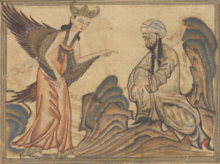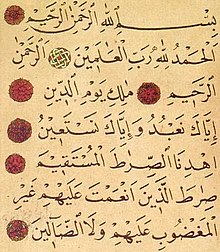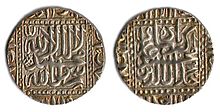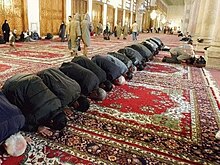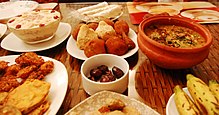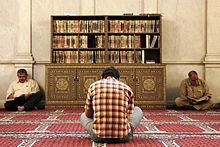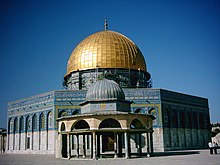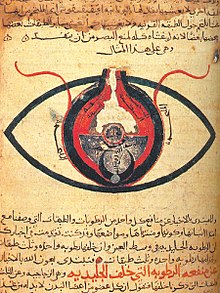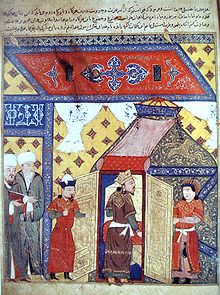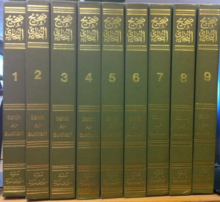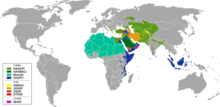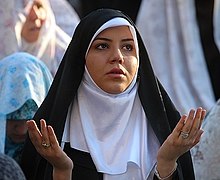Islam
Islam
| Part of a series on |
| Islam |
|---|
 |
Etymology
Articles of faith
God
| Part of a series on |
| God in Islam |
|---|
 |
Angels
Books
Prophets
| hide Part of a series on Islam Islamic prophets |
|---|
 |
Resurrection and judgment
Divine predestination
Acts of worship
Testimony
Prayer
Charity
Fasting
Pilgrimage
Quranic recitation and memorization
Supplication and remembrance
History
Muhammad (610–632)
| Part of a series on |
| Muhammad |
|---|
 |
Caliphate and civil strife (632–750)
Classical era (750–1258)
Pre-Modern era (1258–18th century)
Modern era (18th – 20th centuries)
Contemporary era (20th century–present)
Demographics
Schools and branches
Sunni
| hidePart of a series on |
| Sunni Islam |
|---|
 |
Shia
Ibadi
Other denominations
- Quranists are Muslims who generally believe that Islamic law and guidance should only be based on the Quran, rejecting the Sunnah, thus partially or completely doubting the religious authority, reliability or authenticity of the hadith literature, which they claim are fabricated.[281] From the 19th century onward, hadith were questioned by Sayyid Ahmad Khan, Abdullah Chakralawi, Ghulam Ahmad Parwez,[282] and Muhammad Tawfīq Sidqī .[283][284] Quranists differ in the practice of Islamic rituals from other Muslims in frequency of prayer, details of prayer, zakat, fasting, or the Hajj.[281]
- Bektashi Alevism is a syncretic and heterodox local Islamic tradition, whose adherents follow the mystical (bāṭenī) teachings of Ali and Haji Bektash Veli.[285] Alevism incorporates Turkish beliefs present during the 14th century,[286] such as Shamanism and Animism, mixed with Shias and Sufi beliefs, adopted by some Turkish tribes. It has been estimated that there are 10 million to over 20 million (~ 0.5% - ~ 1% of all Muslims) Alevis worldwide.[287]
- The Ahmadiyya movement was founded by Mirza Ghulam Ahmad[288] in India in 1889.[289][e] Ahmad claimed to be the "Promised Messiah" or "Imam Mahdi" of prophecy. Today the group has 10 to 20 million practitioners, but is rejected by most Muslims as heretical,[290] and Ahmadis have been subject to religious persecution and discrimination since the movement's inception.[291]
Non-denominational Muslims
Mysticism
Law and jurisprudence
| Part of a series on |
| Islamic jurisprudence (fiqh) |
|---|
 |
| Islamic studies |
Schools of jurisprudence
Society
Religious personages
Governance
Daily and family life
Arts and culture
Derived religions
Criticism
See also
- Glossary of Islam
- Index of Islam-related articles
- Islamic studies
- Major religious groups
- Outline of Islam
Notes
- ^ There are ten pronunciations of Islam in English, differing in whether the first or second syllable has the stress, whether the s is /z/ or /s/, and whether the a is pronounced /ɑː/, /æ/ or (when the stress is on the first syllable) /ə/ (Merriam Webster). The most common are /ɪzˈlɑːm, ɪsˈlɑːm, ˈɪzləm, ˈɪsləm/ (Oxford English Dictionary) and /ˈɪzlɑːm, ˈɪslɑːm/ (American Heritage Dictionary).
- ^ Watt argues that the initial agreement came about shortly after the hijra and that the document was amended at a later date—specifically after the battle of Badr (AH [anno hijra] 2, = AD 624).[112] Serjeant argues that the constitution is, in fact, eight different treaties that can be dated according to events as they transpired in Medina, with the first treaty written shortly after Muhammad's arrival.[113] See also Caetani (1905) who argue that the document is a single treaty agreed upon shortly after the hijra.[114] Wellhausen argues that it belongs to the first year of Muhammad's residence in Medina, before the battle of Badr in 2/624.[115] Even Moshe Gil, a sceptic of Islamic history, argues that it was written within five months of Muhammad's arrival in Medina.[116]
- ^ "Hasan al Basri is often considered one of the first who rejected an angelic origin for the devil, arguing that his fall was the result of his own free-will, not God's determination. Hasan al Basri also argued that angels are incapable of sin or errors and nobler than humans and even prophets. Both early Shias and Sunnis opposed his view.[147]
- ^ "In recent years, the idea of syncretism has been challenged. Given the lack of authority to define or enforce an Orthodox doctrine about Islam, some scholars argue there had no prescribed beliefs, only prescribed practise, in Islam before the sixtheenth century.[184](p20–22)
- ^ A figure of 10-20 million represents approximately 1% of the Muslim population. See also: Ahmadiyya by country.
- ^ Some Muslims in dynastic era China resisted footbinding of girls for the same reason.[351]
References
Citations of Qur'an and hadith
- ^ Q6:125 Quran 6:125, Q61:7 Quran 61:7, Q39:22 Quran 39:22
- ^ Q9:74 Quran 9:74; Quran 49:14
- ^ Q2:117 Quran 2:117
- ^ Q51:56 Quran 51:56
- ^ Q2:186 Quran 2:186
- ^ Q35:1 Quran 35:1
- ^ Quran 1:4;
- ^ Quran 6:31;
- ^ Quran 101:1
- ^ Quran 9:60. "Zakat expenditures are only for the poor and for the needy and for those employed to collect (Zakat) and for bringing hearts together and for freeing captives and for those in debt (or bonded labour) and for the cause of Allah and for the (stranded) traveller—an obligation (imposed) by Allah. And Allah is Knowing and Wise"
- ^ Quran 41:34
- ^ Sahih al-Bukhari, 8:73:56
- ^ Quran 4:11.
Citations
- ^ "Muslim." Lexico. UK: Oxford University Press. 2020.
- ^ Esposito, John L. 2009. "Islam." In The Oxford Encyclopedia of the Islamic World, edited by J. L. Esposito. Oxford: Oxford University Press. ISBN 978-0-19-530513-5. (See also: quick reference.) "Profession of Faith...affirms Islam's absolute monotheism and acceptance of Muḥammad as the messenger of Allah, the last and final prophet."
- ^ a b Peters, F. E. 2009. "Allāh." In The Oxford Encyclopedia of the Islamic World, edited by J. L. Esposito. Oxford: Oxford University Press. ISBN 978-0-19-530513-5. (See also: quick reference.) "[T]he Muslims' understanding of Allāh is based...on the Qurʿān's public witness. Allāh is Unique, the Creator, Sovereign, and Judge of mankind. It is Allāh who directs the universe through his direct action on nature and who has guided human history through his prophets, Abraham, with whom he made his covenant, Moses/Moosa, Jesus/Eesa, and Muḥammad, through all of whom he founded his chosen communities, the 'Peoples of the Book.'"
- ^ "Muslim Population By Country 2021". World Population Review. Retrieved 22 July 2021.
- ^ "Religious Composition by Country, 2010–2050". Pew Research Center. 2 April 2015. Archived from the original on 15 June 2020. Retrieved 5 May 2020.
- ^ Campo (2009), p. 34, "Allah".
- ^ Özdemir, İbrahim. 2014. "Environment." In The Oxford Encyclopedia of Philosophy, Science, and Technology in Islam, edited by I. Kalin. Oxford: Oxford University Press. ISBN 978-0-19-981257-8. "When Meccan pagans demanded proofs, signs, or miracles for the existence of God, the Qurʾān's response was to direct their gaze at nature's complexity, regularity, and order. The early verses of the Qurʾān, therefore, reveal an invitation to examine and investigate the heavens and the earth, and everything that can be seen in the environment.... The Qurʾān thus makes it clear that everything in Creation is a miraculous sign of God (āyah), inviting human beings to contemplate the Creator."
- ^ Goldman, Elizabeth. 1995. Believers: Spiritual Leaders of the World. Oxford: Oxford University Press. ISBN 978-0-19-508240-1. p. 63.
- ^ Reeves, J. C. (2004). Bible and Qurʼān: Essays in scriptural intertextuality. Leiden: Brill. p. 177. ISBN 90-04-12726-7.
- ^ Bennett (2010), p. 101.
- ^ Esposito, John L. (ed.). "Eschatology". The Oxford Dictionary of Islam – via Oxford Islamic Studies Online.
- ^ Esposito (2002b), pp. 17, 111–112, 118.
- ^ a b c d Coulson, Noel James. "Sharīʿah". Encyclopædia Britannica. Retrieved 17 September 2021. (See also: "sharia" via Lexico.)
- ^ Trofimov, Yaroslav. 2008. The Siege of Mecca: The 1979 Uprising at Islam's Holiest Shrine. Knopf. New York. ISBN 978-0-307-47290-8. p. 79.
- ^ Watt, William Montgomery (2003). Islam and the Integration of Society. Psychology Press. p. 5. ISBN 978-0-415-17587-6.
- ^ Saliba, George. 1994. A History of Arabic Astronomy: Planetary Theories During the Golden Age of Islam. New York: New York University Press. ISBN 0-8147-8023-7. pp. 245, 250, 256–57.
- ^ King, David A. (1983). "The Astronomy of the Mamluks". Isis. 74 (4): 531–55. doi:10.1086/353360. S2CID 144315162.
- ^ Hassan, Ahmad Y. 1996. "Factors Behind the Decline of Islamic Science After the Sixteenth Century." Pp. 351–99 in Islam and the Challenge of Modernity, edited by S. S. Al-Attas. Kuala Lumpur: International Institute of Islamic Thought and Civilization. Archived from the original on 2 April 2015.
- ^ Arnold, Thomas Walker. The Preaching of Islam: A History of the Propagation of the Muslim Faith. pp. 125–258.
- ^ Denny, Frederick. 2010. Sunni Islam: Oxford Bibliographies Online Research Guide. Oxford: Oxford University Press. p. 3. "Sunni Islam is the dominant division of the global Muslim community, and throughout history it has made up a substantial majority (85 to 90 percent) of that community."
- ^ "Field Listing :: Religions". The World Factbook. Central Intelligence Agency. Archived from the original on 6 July 2010. Retrieved 25 October 2010.
Sunni Islam accounts for over 75% of the world's Muslim population." ... "Shia Islam represents 10–15% of Muslims worldwide.
- ^ "Sunni". Berkley Center for Religion, Peace, and World Affairs. Archived from the original on 14 June 2020. Retrieved 24 May 2020.
Sunni Islam is the largest denomination of Islam, comprising about 85% of the world's over 1.5 billion Muslims.
- ^ a b Pew Forum for Religion & Public Life (2009), p. 1. "Of the total Muslim population, 10–13% are Shia Muslims and 87–90% are Sunni Muslims."
- ^ "Muslim Majority Countries 2021". worldpopulationreview.com. Retrieved 25 July 2021.
- ^ The Pew Forum on Religion and Public Life. December 2012. "The Global Religious Landscape: A Report on the Size and Distribution of the World's Major Religious Groups as of 2010." DC: Pew Research Center. Article.
- ^ Tayeb El-Hibri, Maysam J. al Faruqi (2004). "Sunni Islam". In Philip Mattar (ed.). The Encyclopedia of the Modern Middle East and North Africa (2nd ed.). MacMillan Reference.
- ^ Pew Forum for Religion and Public Life. April 2015. "10 Countries With the Largest Muslim Populations, 2010 and 2050" (projections table). Pew Research Center.
- ^ Pechilis, Karen; Raj, Selva J. (2013). South Asian Religions: Tradition and Today. Routledge. p. 193. ISBN 978-0-415-44851-2.
- ^ a b The Future of the Global Muslim Population (Report). Pew Research Center. 27 January 2011. Archived from the original on 9 February 2011. Retrieved 27 December 2017.
- ^ "Islam in Russia". Al Jazeera. Anadolu News Agency. 7 March 2018. Retrieved 15 June 2021.
- ^ "Book review: Russia's Muslim Heartlands reveals diverse population", The National, 21 April 2018, retrieved 13 January 2019
- ^ Burke, Daniel (2 April 2015). "The world's fastest-growing religion is..." CNN. Retrieved 18 April 2015.
- ^ Lippman, Thomas W. 7 April 2008. "No God But God." U.S. News & World Report. Retrieved 24 May 2020. "Islam is the youngest, the fastest growing, and in many ways the least complicated of the world's great monotheistic faiths. It is based on its own holy book, but it is also a direct descendant of Judaism and Christianity, incorporating some of the teachings of those religions—modifying some and rejecting others."
- ^ "Siin." Lane's Lexicon 4. – via StudyQuran.
- ^ Lewis, Barnard; Churchill, Buntzie Ellis (2009). Islam: The Religion and The People. Wharton School Publishing. p. 8. ISBN 978-0-13-223085-8.
- ^ a b c Gardet & Jomier (2012).
- ^ Esposito (2000), pp. 76–77.
- ^ Mahmutćehajić, Rusmir (2006). The mosque: the heart of submission. Fordham University Press. p. 84. ISBN 978-0-8232-2584-2.
- ^ a b c "What Does "Islam" Mean?". Classical Arabic. 20 June 2020. Retrieved 20 June 2020.
- ^ Wilson, Kenneth G. The Columbia Guide to Standard American English. ISBN 0-231-06989-8. p. 291: "Muhammadan and Mohammedan are based on the name of the prophet Mohammed, and both are considered offensive."
- ^ See:
- Esposito (2002b), pp. 74–76
- Esposito (2004), p. 22
- Griffith & Savage (2006), p. 248
- "Tawhid". Encyclopædia Britannica. Retrieved 17 September 2021.
- ^ "Surah Al-Ma'idah – 5:73". quran.com. Retrieved 26 March 2021.
- ^ Bentley, David (1999). The 99 Beautiful Names for God for All the People of the Book. William Carey Library. ISBN 978-0-87808-299-5.
- ^ Ali, Kecia; Leaman, Oliver (2008). Islam : the key concepts. London: Routledge. ISBN 978-0-415-39638-7. OCLC 123136939.
- ^ a b c d Schimmel, Annemarie. "Islam". Encyclopædia Britannica. Retrieved 17 September 2021.
- ^ "Human Nature and the Purpose of Existence". Patheos. Retrieved 24 May 2020.
- ^ Leeming, David. 2005. The Oxford Companion to World Mythology. Oxford: Oxford University Press. ISBN 978-0-195-15669-0. p. 209.
- ^ See:
- "God". Islam: Empire of Faith. PBS. Retrieved 18 December 2010.
- Fahlbusch et al (2001), "Islam and Christianity": Arabic-speaking Christians and Jews also refer to God as Allāh.
- L. Gardet. "Allah". In Encyclopaedia of Islam Online (n.d.).
- ^ Burge (2015), p. 23.
- ^ a b Burge (2015), p. 79.
- ^ See:
- "Nūr." The Concise Oxford Dictionary of World Religions. – via Encyclopedia.com.
- Hartner, W.; Tj Boer. "Nūr". In Encyclopaedia of Islam (2nd ed.) (2012). doi:10.1163/1573-3912_islam_COM_0874.
- Elias, Jamal J. "Light". In McAuliffe (2003). doi:10.1163/1875-3922_q3_EQSIM_00261
- ^ See:
- Campo, Juan E. "Nar". In Martin (2004).. – via Encyclopedia.com.
- Fahd, T. "Nār". In Encyclopaedia of Islam (2nd ed.) (2012). doi:10.1163/1573-3912_islam_COM_0846.
- Toelle, Heidi. "Fire". In McAuliffe (2002). doi:10.1163/1875-3922_q3_EQSIM_00156.
- McAuliffe (2003), p. 45.
- ^ Burge (2015), pp. 97–99.
- ^ See:
- Esposito (2002b), pp. 26–28.
- Webb, Gisela. "Angel". In McAuliffe (n.d.)..
- MacDonald, D. B.; Madelung, W. "Malāʾika". In Encyclopaedia of Islam (2nd ed.) (2012).. doi:10.1163/1573-3912_islam_COM_0642.
- ^ Çakmak (2017), p. 140.
- ^ Burge (2015), p. 22.
- ^ See:
- Accad (2003): According to Ibn Taymiya, although only some Muslims accept the textual veracity of the entire Bible, most Muslims will grant the veracity of most of it.
- Esposito (1998), pp. 6, 12
- Esposito (2002b), pp. 4–5
- Peters (2003), p. 9
- Buhl, F.; Welch, A.T. "Muhammad". In Encyclopaedia of Islam Online (n.d.).
- Hava Lazarus-Yafeh. "Tahrif". In Encyclopaedia of Islam Online (n.d.).
- ^ a b Ringgren, Helmer. "Qurʾān". Encyclopædia Britannica. Retrieved 17 September 2021. "The word Quran was invented and first used in the Qurʼan itself. There are two different theories about this term and its formation."
- ^ See:
- Teece (2003), pp. 12–13
- Turner (2006), p. 42
- ^ Esposito (2004), pp. 17–18, 21.
- ^ Al Faruqi; Lois Ibsen (1987). "The Cantillation of the Qur'an". Asian Music (Autumn – Winter 1987): 3–4.
- ^ "Tafsīr". Encyclopædia Britannica. Retrieved 17 September 2021.
- ^ Esposito (2004), pp. 79–81.
- ^ Jones, Alan (1994). The Koran. London. p. 1. ISBN 1842126091.
Its outstanding literary merit should also be noted: it is by far, the finest work of Arabic prose in existence.
- ^ Arberry, Arthur (1956). The Koran Interpreted. London. p. 191. ISBN 0684825074.
It may be affirmed that within the literature of the Arabs, wide and fecund as it is both in poetry and in elevated prose, there is nothing to compare with it.
- ^ Kadi, Wadad, and Mustansir Mir. "Literature and the Quran." In Encyclopaedia of the Qur'an 3. pp. 213, 216.
- ^ Esposito, J. L. (2003). The Oxford Dictionary of Islam. Vereinigtes Königreich: Oxford University Press, USA. p. 225
- ^ See:
- Martin (2004), p. 666.
- J. Robson. "Hadith". In Encyclopaedia of Islam Online (n.d.).
- D.W. Brown. "Sunna". In Encyclopaedia of Islam Online (n.d.).
- ^ Brown, Jonathan. 2007. The Canonization of Al-Bukhārī and Muslim: The Formation and Function of the Sunnī Ḥadīth Canon[page needed]. Leiden: Brill. ISBN 978-90-04-15839-9.
- ^ al-Rahman, Aisha Abd, ed. 1990. Muqaddimah Ibn al-Ṣalāḥ. Cairo: Dar al-Ma'arif, 1990. pp. 160–69
- ^ Meri, Josef W. (2005). Medieval Islamic Civilization: An Encyclopedia. USA: Routledge. ISBN 978-0-415-96690-0.
- ^ Awliya'i, Mustafa. "The Four Books." In Outlines of the Development of the Science of Hadith 1, translated by A. Q. Qara'i. – via Al-Islam.org. Retrieved 24 May 2020.
- ^ Rizvi, Sayyid Sa'eed Akhtar. "The Hadith §The Four Books (Al-Kutubu’l-Arb’ah)." Ch 4 in The Qur’an and Hadith. Tanzania: Bilal Muslim Mission. – via Al-Islam.org. Retrieved 24 May 2020.
- ^ See:
- Glassé (2003), pp. 382–383, "Resurrection".
- Encyclopaedia of Islam (2nd ed.) (2012), "Avicenna". doi:10.1163/1573-3912_islam_DUM_0467: "Ibn Sīnā, Abū ʿAlī al-Ḥusayn b. ʿAbd Allāh b. Sīnā is known in the West as 'Avicenna'."
- Gardet, L. "Qiyama". In Encyclopaedia of Islam Online (n.d.).
- ^ Masri, Basheer Ahmad. Animals in Islam. p. 27.
- ^ Esposito (2011), p. 130.
- ^ See:
- Smith (2006), p. 89; Encyclopedia of Islam and Muslim World, p. 565
- Lagasse et al. (2000), "Heaven"
- Asma Afsaruddin. "Garden". In McAuliffe (n.d.).
- "Paradise". Encyclopædia Britannica Online.
- ^ "Andras Rajki's A. E. D. (Arabic Etymological Dictionary)". 2002. Archived from the original on 8 December 2011. Retrieved 13 November 2020.
- ^ See:
- Cohen-Mor (2001), p. 4: "The idea of predestination is reinforced by the frequent mention of events 'being written' or 'being in a book' before they happen": Say: "Nothing will happen to us except what Allah has decreed for us..."
- Karamustafa, Ahmet T. "Fate". In McAuliffe (n.d.).: The verb qadara literally means "to measure, to determine". Here it is used to mean that "God measures and orders his creation".
- Gardet, L. "al-Ḳaḍāʾ Wa ’l-Ḳadar". In Encyclopaedia of Islam (2nd ed.) (2012). doi:10.1163/1573-3912_islam_COM_0407
- ^ "Muslim beliefs – Al-Qadr". Bitesize – GCSE – Edexcel. BBC. Retrieved 13 November 2020.
- ^ Siddiqui, Abdur Rashid; Islamic Foundation Staff (Great Britain) (2015). Qur'anic Keywords: a Reference Guide. New York: Kube Publishing. ISBN 978-0-86037-676-7. OCLC 947732907.
- ^ Toropov, Brandon; Buckles, Luke (2004). Complete Idiot's Guide to World Religions. Alpha. ISBN 978-1-59257-222-9.
- ^ "Pillars of Islam | Islamic Beliefs & Practices | Britannica". www.britannica.com.
- ^ Nasr (2003), pp. 3, 39, 85, 270–272.
- ^ Mohammad, N. 1985. "The doctrine of jihad: An introduction." Journal of Law and Religion 3(2):381–97.
- ^ Kasim, Husain. "Islam". In Salamone (2004), pp. 195–197.
- ^ Farah (1994), p. 135.
- ^ Galonnier, Juliette. "Moving In or Moving Toward? Reconceptualizing Conversion to Islam as a Liminal Process1". Moving In and Out of Islam, edited by Karin van Nieuwkerk, New York, USA: University of Texas Press, 2021, pp. 44-66. https://doi.org/10.7560/317471-003
- ^ See:
- Esposito (2002b), pp. 18, 19
- Hedayetullah (2006), pp. 53–55
- Kobeisy (2004), pp. 22–34
- Momen (1987), p. 178
- ^ Mattson, Ingrid (2006). "Women, Islam, and Mosques". In R. S. Keller and R. R. Ruether (eds.). Encyclopedia of Women and Religion in North America. Volume 2, Part VII. Islam. Bloomington and Indianapolis: Indiana University Press. pp. 615–629. ISBN 978-0-253-34687-2.
- ^ See:
- Pedersen, J., R. Hillenbrand, J. Burton-Page, et al. 2010. “Masd̲j̲id.” Encyclopedia of Islam. Leiden: Brill. Retrieved 25 May 2020.
- "Mosque". Encyclopædia Britannica. Retrieved 17 September 2021.
- ^ Ahmed, Medani, and Sebastian Gianci. "Zakat." p. 479 in Encyclopedia of Taxation and Tax Policy.
- ^ Ariff, Mohamed (1991). The Islamic Voluntary Sector in Southeast Asia: Islam and the Economic Development of Southeast Asia. Institute of Southeast Asian Studies. pp. 55–. ISBN 978-981-3016-07-1.
- ^ "A faith-based aid revolution in the Muslim world". The New Humanitarian. 1 June 2012. Retrieved 24 September 2013.
- ^ Said, Abdul Aziz; et al. (2006). Contemporary Islam: Dynamic, Not Static. Taylor & Francis. p. 145. ISBN 978-0-415-77011-8.
- ^ Stefon (2010), p. 72.
- ^ Monica M. Gaudiosi (1988). The Influence of the Islamic Law of Waqf on the Development of the Trust in England: The Case of Merton College. University of Pennsylvania.[page needed]
- ^ Hudson, A. (2003). Equity and Trusts (3rd ed.). London: Cavendish Publishing. p. 32. ISBN 1-85941-729-9.
- ^ "The insider's guide to Ramadan". CNN International. 25 September 2006. Retrieved 15 August 2010.
- ^ Peters, F.E. (2009). Islam: A Guide for Jews and Christians. p. 20. ISBN 978-1-4008-2548-6. Retrieved 7 October 2014.
- ^ See:
- Goldschmidt & Davidson (2005), p. 48
- Farah (1994), pp. 145–147
- "Hajj". Encyclopædia Britannica Online.
- ^ Cornell, Vincent J. (2007). Voices of Islam: Voices of tradition. Greenwood Publishing Group. p. 29. ISBN 978-0-275-98733-6. Retrieved 26 August 2012.
- ^ Glassé, Cyril; Smith, Huston (1 February 2003). The New Encyclopedia of Islam. Rowman Altamira. p. 207. ISBN 978-0-7591-0190-6. Retrieved 26 August 2012.
- ^ a b Nigosian (2004), p. 70.
- ^ a b Stefon (2010), p. 42–43.
- ^ Esposito (2010), p. 6.
- ^ a b "Islam". History Channel. A&E Television Networks. 8 October 2019 [5 January 2018]. Retrieved 24 May 2020.
- ^ See:
- Quran 18:110
- Buhl, F.; Welch, A.T. "Muhammad". In Encyclopaedia of Islam Online (n.d.).
- ^ See:
- Esposito (1998), p. 12
- Esposito (2002b), pp. 4–5
- Peters (2003), p. 9
- "Muhammad". Encyclopædia Britannica Online.
- ^ Ünal, Ali (2006). The Qurʼan with Annotated Interpretation in Modern English. Tughra Books. pp. 1323–. ISBN 978-1-59784-000-2.
- ^ See:
- "Slaves and Slavery." Encyclopedia of the Qur'an.
- Rabah, Bilal B. Encyclopedia of Islam.
- Holt, Lambton & Lewis (1977), p. 36.
- ^ Watt. Muhammad at Medina. pp. 227–228.[full citation needed]
- ^ Serjeant, R.B. "The Sunnah Jâmi'ah, Pacts with the Yathrib Jews, and the Tahrîm of Yathrib: Analysis and Translation of the Documents Comprised in the so-called 'Constitution of Medina'." in The Life of Muhammad: The Formation of the Classical Islamic World: Volume iv. Ed. Uri Rubin. Brookfield: Ashgate Publishing, 1998, p. 151 and see same article in Serjeant (1978), pp. 18 ff.
- ^ Caetani (1905). Annali dell'Islam, Volume I. Milano: Hoepli. p. 393.
- ^ Julius Wellhausen. Skizzen und Vorabeiten, IV, Berlin: Reimer, 1889, p. 82f.
- ^ Moshe Gil. 1974. "The Constitution of Medina: A Reconsideration." Israel Oriental Studies 4. p. 45.
- ^ Serjeant (1978), p. 4.
- ^ See:
- Peters (2003), pp. 78–79, 194
- Lapidus (2002), pp. 23–28
- ^ Buhl, F.; Welch, A.T. "Muhammad". In Encyclopaedia of Islam Online (n.d.).
- ^ Melchert, Christopher (2020). "The Rightly Guided Caliphs: The Range of Views Preserved in Ḥadīth". In al-Sarhan, Saud (ed.). Political Quietism in Islam: Sunni and Shi'i Practice and Thought. London and New York: I.B. Tauris. pp. 70–71. ISBN 978-1-83860-765-4.
- ^ Esposito (2003), p. [page needed], "Rightly Guided Caliphs".
- ^ See:
- Holt & Lewis (1977), p. 57
- Hourani (2002), p. 22
- Lapidus (2002), p. 32
- Madelung (1996), p. 43
- Ṭabāṭabāʼī (1979), pp. 30–50
- ^ See
- Holt & Lewis (1977), p. 74
- Gardet & Jomier (2012)
- ^ Esposito (2010), p. 38.
- ^ Holt & Lewis (1977), pp. 67–72.
- ^ Harney, John (3 January 2016). "How Do Sunni and Shia Islam Differ?". The New York Times. Retrieved 4 January 2016.
- ^ Waines (2003), p. 46.
- ^ Ismāʻīl ibn ʻUmar Ibn Kathīr (2012), p. 505.
- ^ Umar Ibn Abdul Aziz By Imam Abu Muhammad Abdullah ibn Abdul Hakam died 214 AH 829 C.E. Publisher Zam Zam Publishers Karachi, pp. 54–59
- ^ Ismāʻīl ibn ʻUmar Ibn Kathīr (2012), p. 522.
- ^ "Al-Muwatta'". Retrieved 7 October 2014.
- ^ Noel James Coulson (1964). History of Islamic Law. p. 103. ISBN 978-0-7486-0514-9. Retrieved 7 October 2014.
- ^ Houtsma, M.T.; Wensinck, A.J.; Lévi-Provençal, E.; Gibb, H.A.R.; Heffening, W., eds. (1993). E.J. Brill's First Encyclopaedia of Islam, 1913–1936. Volume V: L—Moriscos (reprint ed.). Brill Publishers. pp. 207–. ISBN 978-90-04-09791-9.
- ^ Moshe Sharon, ed. (1986). Studies in Islamic History and Civilization: In Honour of Professor David Ayalon. BRILL. p. 264. ISBN 9789652640147.
- ^ Mamouri, Ali (8 January 2015). "Who are the Kharijites and what do they have to do with IS?". Al-monitor. Retrieved 6 March 2022.
- ^ Blankinship (2008), p. 43.
- ^ a b c Esposito (2010), p. 87.
- ^ Puchala, Donald (2003). Theory and History in International Relations. Routledge. p. 137.
- ^ Esposito (2010), p. 45.
- ^ Al-Biladhuri, Ahmad Ibn Jabir; Hitti, Philip (1969). Kitab Futuhu'l-Buldan. AMS Press. p. 219.
- ^ Lapidus (2002), p. 56.
- ^ Lewis (1993), pp. 71–83.
- ^ Lapidus (2002), p. 86.
- ^ a b Schimmel, Annemarie. "Sufism". Encyclopædia Britannica. Retrieved 17 September 2021.
- ^ Lapidus (2002), pp. 90, 91.
- ^ Blankinship (2008), pp. 38–39.
- ^ Omar Hamdan Studien zur Kanonisierung des Korantextes: al-Ḥasan al-Baṣrīs Beiträge zur Geschichte des Korans Otto Harrassowitz Verlag 2006 ISBN 978-3447053495 pp. 291–292 (German)
- ^ Blankinship (2008), p. 50.
- ^ Esposito (2010), p. 88.
- ^ Doi, Abdur Rahman (1984). Shariah: The Islamic Law. London: Ta-Ha Publishers. p. 110. ISBN 978-0-907461-38-8.
- ^ See:
- Lapidus (2002), p. 160
- Waines (2003), pp. 126–127
- ^ See:
- Holt & Lewis (1977), pp. 80, 92, 105
- Holt, Lambton & Lewis (1977), pp. 661–663
- Lapidus (2002), p. 56
- Lewis (1993), p. 84
- Gardet & Jomier (2012)
- ^ a b Jacquart, Danielle (2008). "Islamic Pharmacology in the Middle Ages: Theories and Substances". European Review (Cambridge University Press) 16: 219–227.
- ^ David W. Tschanz, MSPH, PhD (August 2003). "Arab Roots of European Medicine", Heart Views 4 (2).
- ^ Brater, D. Craig; Daly, Walter J. (2000). "Clinical pharmacology in the Middle Ages: Principles that presage the 21st century". Clinical Pharmacology & Therapeutics. 67 (5): 447–450 [448]. doi:10.1067/mcp.2000.106465. PMID 10824622. S2CID 45980791.
- ^ Toomer, Gerald (1990). "Al-Khwārizmī, Abu Jaʿfar Muḥammad ibn Mūsā". In Gillispie, Charles Coulston. Dictionary of Scientific Biography. 7. New York: Charles Scribner's Sons. ISBN 0-684-16962-2.
- ^ Micheau, Françoise; Morelon, Régis (1996). "The scientific institutions in the medieval Near East". In Rāshid, Rushdī (ed.). Encyclopedia of the History of Arabic Science, Volume 3: Technology, alchemy and life sciences. CRC Press. pp. 991–992. ISBN 978-0-415-12412-6.
- ^ "The beginnings of modern medicine: the Caliphate". Planetseed.com. Archived from the original on 15 July 2011. Retrieved 29 January 2011.
- ^ Alatas, Syed Farid (2006). "From Jami'ah to University: Multiculturalism and Christian–Muslim Dialogue". Current Sociology. 54 (1): 112–132. doi:10.1177/0011392106058837. S2CID 144509355.
- ^ Imamuddin, S.M. (1981). Muslim Spain 711–1492 AD. Brill Publishers. p. 169. ISBN 978-90-04-06131-6.
- ^ Young, Mark (1998). The Guinness Book of Records. p. 242. ISBN 978-0-553-57895-9.
- ^ Makdisi, George (April–June 1989). "Scholasticism and Humanism in Classical Islam and the Christian West". Journal of the American Oriental Society. 109 (2): 175–182 [175–177]. doi:10.2307/604423. JSTOR 604423.
- ^ a b Ahmed (2006), pp. 23, 42, 84. "Despite the fact that they did not have a quantified theory of error they were well aware that an increased number of observations qualitatively reduces the uncertainty."
- ^ Haq, Syed (2009). "Science in Islam". Oxford Dictionary of the Middle Ages. ISSN 1703-7603. Retrieved 22 October 2014
- ^ Toomer, G. J. (December 1964). "Review Work: Matthias Schramm (1963) Ibn Al-Haythams Weg zur Physik". Isis. 55 (4): 464. JSTOR 228328.
Schramm sums up [Ibn Al-Haytham's] achievement in the development of scientific method.
- ^ Al-Khalili, Jim (4 January 2009). "The 'first true scientist'". BBC News. Retrieved 24 September 2013.
- ^ Gorini, Rosanna (October 2003). "Al-Haytham the man of experience. First steps in the science of vision" (PDF). Journal of the International Society for the History of Islamic Medicine. 2 (4): 53–55. Retrieved 25 September 2008.
- ^ Al-Khalili, Jim (30 January 2008). "It's time to herald the Arabic science that prefigure Darwin and Newton". The Guardian. Retrieved 24 September 2013.
- ^ Al-Khalili, Jim (29 January 2008). "Science: Islam's forgotten geniuses". The Telegraph. Archived from the original on 23 July 2009. Retrieved 13 December 2011.
- ^ a b Esposito (2010), p. 150.
- ^ Hamad Subani The Secret History of Iran Lulu.com 2013 ISBN 978-1-304-08289-3 74
- ^ Neue Fischer Weltgeschichte "Islamisierung in Zentralasien bis zur Mongolenzeit“ Band 10: Zentralasien, 2012, p. 191 (German)
- ^ Glubb, John Bagot. "Mecca (Saudi Arabia)". Encyclopædia Britannica. Retrieved 18 September 2021.
- ^ Andreas Graeser Zenon von Kition: Positionen u. Probleme Walter de Gruyter 1975 ISBN 978-3-11-004673-1 p. 260
- ^ The preaching of Islam: a history of the propagation of the Muslim faith By Sir Thomas Walker Arnold, pp. 227-228
- ^ Majumdar, Dr. R.C., History of Mediaeval Bengal, First published 1973, Reprint 2006, Tulshi Prakashani, Kolkata, ISBN 81-89118-06-4
- ^ Bowering et al., The Princeton Encyclopedia of Islamic Political Thought, ISBN 978-0-691-13484-0, Princeton University Press
- ^ "Islam in China". BBC. Retrieved 10 August 2011.
- ^ "The Spread of Islam" (PDF). Retrieved 2 November 2013.
- ^ "Ottoman Empire". Oxford Islamic Studies Online. 6 May 2008. Retrieved 26 August 2010.
- ^ Adas, Michael, ed. (1993). Islamic and European Expansion. Philadelphia: Temple University Press. p. 25.
- ^ Metcalf, Barbara (2009). Islam in South Asia in Practice. Princeton University Press. p. 104.
- ^ a b Çakmak (2017), pp. 1425–1429.
- ^ a b Peacock, A.C.S. (2019). Islam, Literature and Society in Mongol Anatolia. Cambridge University Press. doi:10.1017/9781108582124. ISBN 978-1-108-58212-4. S2CID 211657444.
- ^ Israeli, Raphael (2002). Islam in China. p. 292. Lexington Books. ISBN 0-7391-0375-X.
- ^ Dillon, Michael (1999). China's Muslim Hui Community. Curzon. p. 37. ISBN 978-0-7007-1026-3.
- ^ Bulliet (2005), p. 497
- ^ Subtelny, Maria Eva (November 1988). "Socioeconomic Bases of Cultural Patronage under the Later Timurids". International Journal of Middle East Studies. 20 (4): 479–505. doi:10.1017/S0020743800053861. Retrieved 7 November 2016.
- ^ "Ghiyath al-Din Jamshid Mas'ud al-Kashi". University of St Andrews. 1999. Retrieved 29 December 2021.
- ^ Hassan, Mona (2018). Longing for the Lost Caliphate: A Transregional History. Princeton University Press.
- ^ Drews, Robert (August 2011). "Chapter Thirty – "The Ottoman Empire, Judaism, and Eastern Europe to 1648"" (PDF). Coursebook: Judaism, Christianity and Islam, to the Beginnings of Modern Civilization. Vanderbilt University.
- ^ Peter B. Golden: An Introduction to the History of the Turkic Peoples; In: Osman Karatay, Ankara 2002, p. 321
- ^ Maddison, Angus (2003): Development Centre Studies The World Economy Historical Statistics: Historical Statistics, OECD Publishing, ISBN 92-64-10414-3, pages 259–261
- ^ Giorgio Riello, Tirthankar Roy (2009). How India Clothed the World: The World of South Asian Textiles, 1500–1850. Brill Publishers. p. 174. ISBN 978-90-474-2997-5.
- ^ Sanjay Subrahmanyam (1998). Money and the Market in India, 1100–1700. Oxford University Press. ISBN 978-0-521-25758-9.
- ^ Abhay Kumar Singh (2006). Modern World System and Indian Proto-industrialization: Bengal 1650–1800, (Volume 1). Northern Book Centre. ISBN 978-81-7211-201-1.
- ^ Jens Peter Laut Vielfalt türkischer Religionen Albert-Ludwigs-Universität Freiburg (German) p. 31
- ^ Ga ́bor A ́goston, Bruce Alan Masters Encyclopedia of the Ottoman Empire Infobase Publishing 2010 ISBN 978-1-4381-1025-7 p. 540
- ^ Algar, Ayla Esen (1 January 1992). The Dervish Lodge: Architecture, Art, and Sufism in Ottoman Turkey. University of California Press. ISBN 978-0-520-07060-8. Retrieved 29 April 2020 – via Google Books.
- ^ Wasserstein, David J.; Ayalon, Ami (17 June 2013). Mamluks and Ottomans: Studies in Honour of Michael Winter. Routledge. ISBN 978-1-136-57917-2. Retrieved 29 April 2020 – via Google Books.
- ^ "Ismail Safavi". Encyclopædia Iranica.[full citation needed]
- ^ Mahmoud A. El-Gamal (2006). Islamic Finance: Law, Economics, and Practice. Cambridge University Press. p. 122. ISBN 978-1-139-45716-3.
- ^ a b Spencer C. Tucker; Priscilla Mary Roberts, eds. (2008). The Encyclopedia of the Arab-Israeli Conflict: A Political, Social and Military History. ABC-CLIO. p. 917. ISBN 978-1-85109-842-2.
- ^ a b Frederic M. Wehrey (2010). The Iraq Effect: The Middle East After the Iraq War. Rand Corporation. p. 91. ISBN 978-0-8330-4788-5.
- ^ Ernest Tucker (1994). "Nadir Shah and the Ja 'fari Madhhab Reconsidered". Iranian Studies. 27 (1–4): 163–179. doi:10.1080/00210869408701825. JSTOR 4310891.
- ^ Ernest Tucker (29 March 2006). "Nāder Shāh". Encyclopædia Iranica.
- ^ a b Mary Hawkesworth, Maurice Kogan Encyclopedia of Government and Politics: 2-volume set Routledge 2013 ISBN 978-1-136-91332-7 pp. 270–271
- ^ Richard Gauvain Salafi Ritual Purity: In the Presence of God Routledge 2013 ISBN 978-0-7103-1356-0 p. 6
- ^ Spevack, Aaron (2014). The Archetypal Sunni Scholar: Law, Theology, and Mysticism in the Synthesis of al-Bajuri. SUNY Press. pp. 129–130. ISBN 978-1-4384-5371-2.
- ^ Donald Quataert The Ottoman Empire, 1700–1922 Cambridge University Press 2005 ISBN 978-0-521-83910-5 p. 50
- ^ a b Ga ́bor A ́goston, Bruce Alan Masters Encyclopedia of the Ottoman Empire Infobase Publishing 2010 ISBN 978-1-4381-1025-7 p. 260
- ^ Esposito (2010), p. 146.
- ^ "Graves desecrated in Mizdah". Libya Herald. 4 September 2013. Retrieved 2 November 2013.
- ^ Nicolas Laos The Metaphysics of World Order: A Synthesis of Philosophy, Theology, and Politics Wipf and Stock Publishers 2015 ISBN 978-1-4982-0102-5 p. 177
- ^ Rubin, Barry M. (2000). Guide to Islamist Movements. M.E. Sharpe. p. 79. ISBN 0-7656-1747-1. Retrieved 28 June 2010.
- ^ Esposito (2010), p. 147.
- ^ Esposito (2010), p. 149.
- ^ Robert L. Canfield (2002). Turko-Persia in Historical Perspective. Cambridge University Press. pp. 131–. ISBN 978-0-521-52291-5.
- ^ Sanyal, Usha (23 July 1998). "Generational Changes in the Leadership of the Ahl-e Sunnat Movement in North India during the Twentieth Century". Modern Asian Studies. 32 (3): 635–656. doi:10.1017/S0026749X98003059 – via Cambridge Core.
- ^ "Search Results". oxfordreference.com.
- ^ Lapidus (2002), pp. 358, 378–380, 624.
- ^ Buzpinar, Ş. Tufan (March 2007). "Celal Nuri's Concepts of Westernization and Religion". Middle Eastern Studies. 43 (2): 247–258. doi:10.1080/00263200601114091. JSTOR 4284539. S2CID 144461915.
- ^ Robert Rabil Salafism in Lebanon: From Apoliticism to Transnational Jihadism Georgetown University Press 2014 ISBN 978-1-62616-118-4 chapter: "Doctrine"
- ^ Lauziere, Henri (2016). The Making of Salafism: ISLAMIC REFORM IN THE TWENTIETH CENTURY. New York, Chichester, West Sussex: Columbia University Press. pp. 231–232. ISBN 978-0-231-17550-0.
Beginning with Louis Massignon in 1919, it is true that Westerners played a leading role in labeling Islamic modernists as Salafis, even though the term was a misnomer. At the time, European and American scholars felt the need for a useful conceptual box to place Muslim figures such as Jamal al-Din al-Afghani, Muhammad Abduh, and their epigones, all of whom seemed inclined toward a scripturalist understanding of Islam but proved open to rationalism and Western modernity. They chose to adopt salafiyya—a technical term of theology, which they mistook for a reformist slogan and wrongly associated with all kinds of modernist Muslim intellectuals.
- ^ Henri Lauzière The Making of Salafism: Islamic Reform in the Twentieth Century Columbia University Press 2015 ISBN 978-0-231-54017-9
- ^ "Political Islam: A movement in motion". Economist Magazine. 3 January 2014. Retrieved 1 January 2014.
- ^ Ashk Dahlen Islamic Law, Epistemology and Modernity: Legal Philosophy in Contemporary Iran Routledge 2004 ISBN 978-1-135-94355-4
- ^ "New Turkey". Al-Ahram Weekly. No. 488. 29 June – 5 July 2000. Archived from the original on 4 October 2010. Retrieved 16 May 2010.
- ^ Mango, Andrew (26 August 2002). Ataturk: The Biography of the founder of Modern Turkey. Abrams Books. ISBN 978-1-59020-924-0. Retrieved 29 April 2020 – via Google Books.
- ^ İnalcık, Halil (29 April 1982). "The Caliphate and Ataturk's Inkilab". Türk Tarih Kurumu. Retrieved 29 April 2020 – via Google Books.
- ^ "Organization of the Islamic Conference". BBC News. 26 December 2010. Retrieved 24 September 2013.
- ^ Haddad & Smith (2002), p. 271.
- ^ Bulliet (2005), p. 722
- ^ "Are secular forces being squeezed out of Arab Spring?". BBC News. 9 August 2011. Retrieved 10 August 2011.
- ^ Slackman, Michael (23 December 2008). "Jordanian students rebel, embracing conservative Islam". New York Times. Retrieved 15 August 2011.
- ^ Kirkpatrick, David D. (3 December 2011). "Egypt's vote puts emphasis on split over religious rule". The New York Times. Retrieved 8 December 2011.
- ^ Lauziere, Henri (2016). The Making of Salafism: ISLAMIC REFORM IN THE TWENTIETH CENTURY. New York, Chichester, West Sussex: Columbia University Press. p. 237. ISBN 978-0-231-17550-0.
Prior to the fall of the Ottoman Empire, leading reformers who happened to be Salafi in creed were surprisingly open-minded: although they adhered to neo-Hanbali theology. However, the aftermath of the First World War and the expansion of European colonialism paved the way for a series of shifts in thought and attitude. The experiences of Rida offer many examples... he turned against the Shi'is who dared, with reason, to express doubts about the Saudi-Wahhabi project... . Shi'is were not the only victims: Rida and his associates showed their readiness to turn against fellow Salafis who questioned some of the Wahhabis’ religious interpretations.
- ^ G. Rabil, Robert (2014). Salafism in Lebanon: From Apoliticism to Transnational Jihadism. Washington DC, USA: Georgetown University Press. pp. 32–33. ISBN 978-1-62616-116-0.
Western colonialists established in these countries political orders... that, even though not professing enmity to Islam and its institutions, left no role for Islam in society. This caused a crisis among Muslim reformists, who felt betrayed not only by the West but also by those nationalists, many of whom were brought to power by the West... Nothing reflects this crisis more than the ideological transformation of Rashid Rida (1865–1935)... He also revived the works of Ibn Taymiyah by publishing his writings and promoting his ideas. Subsequently, taking note of the cataclysmic events brought about by Western policies in the Muslim world and shocked by the abolition of the caliphate, he transformed into a Muslim intellectual mostly concerned about protecting Muslim culture, identity, and politics from Western influence. He supported a theory that essentially emphasized the necessity of an Islamic state in which the scholars of Islam would have a leading role... Rida was a forerunner of Islamist thought. He apparently intended to provide a theoretical platform for a modern Islamic state. His ideas were later incorporated into the works of Islamic scholars. Significantly, his ideas influenced none other than Hassan al-Bannah, founder of the Muslim Brotherhood in Egypt... The Muslim Brethren have taken up Rida’s Islamic fundamentalism, a right-wing radical movement founded in 1928,..
- ^ "Huge rally for Turkish secularsim". BBC News. 29 April 2011. Retrieved 6 December 2011.
- ^ Saleh, Heba (15 October 2011). "Tunisia moves against headscarves". BBC News. Retrieved 6 December 2011.
- ^ "Laying down the law: Islam's authority deficit". The Economist. 28 June 2007. Retrieved 15 August 2011.
- ^ Binder, Leonard (1988). Islamic liberalism: a critique of development ideologies. University of Chicago Press. ISBN 978-0-226-05147-5.
- ^ "Ultraconservative Islam on rise in Mideast". MSNBC. 18 October 2008. Retrieved 24 September 2013.
- ^ Almukhtar, Sarah; Peçanha, Sergio; Wallace, Tim (5 January 2016). "Behind Stark Political Divisions, a More Complex Map of Sunnis and Shiites". The New York Times. Retrieved 6 January 2016.
- ^ "Why dissidents are gathering in Istanbul". The Economist. 11 October 2018. Retrieved 6 January 2022.
- ^ Thames, Knox. "Why the Persecution of Muslims Should Be on Biden's Agenda". Foreign Policy Magazine. Retrieved 5 February 2022.
- ^ Perrin, Andrew (10 October 2003). "Weakness in numbers". Time. Retrieved 24 September 2013.
- ^ Beydoun, Khaled A. "For China, Islam is a 'mental illness' that needs to be 'cured'". Al Jazeera. Archived from the original on 10 December 2018. Retrieved 5 February 2022.
- ^ Slackman, Michael (28 January 2007). "In Egypt, a new battle begins over the veil". The New York Times. Retrieved 15 August 2011.
- ^ Nigosian (2004), p. 41.
- ^ "Islamic televangelist; holy smoke". The Economist. Retrieved 5 February 2022.
- ^ Esposito (2010), p. 263.
- ^ V. Šisler: The Internet and the Construction of Islamic Knowledge in Europe p. 212
- ^ Esposito (2004), pp. 118–119, 179.
- ^ Rippin (2001), p. 288.
- ^ Lipka, Michael, and Conrad Hackett. [2015] 6 April 2017. "Why Muslims are the world's fastest-growing religious group" (data analysis). Fact Tank. Pew Research Center.
- ^ David B. Barrett, George T. Kurian, and Todd M. Johnson, World Christian Encyclopedia: A comparative survey of churches and religions in the modern world, Vol. 1: The world by countries: religionists, churches, ministries 2d ed. (New York: Oxford Univ. Press, 2001), 4.
- ^ a b Pew Forum for Religion & Public Life. April 2015. "The Future of World Religions: Population Growth Projections, 2010–2050." Pew Research Center. p. 70 Article.
- ^ Pew Forum for Religion & Public Life (2009), p. 11.
- ^ Ba-Yunus, Ilyas; Kone, Kassim (2006). Muslims in the United States. Greenwood Publishing Group. p. 172. ISBN 978-0-313-32825-1.
- ^ "Secrets of Islam". U.S. News & World Report. Retrieved 24 September 2013. Information provided by the International Population Center, Department of Geography, San Diego State University (2005).
- ^ Pew Forum for Religion & Public Life (2009), pp. 15, 17.
- ^ "Explore All Countries – China". The World Factbook. Central Intelligence Agency. Retrieved 15 September 2009.
- ^ "China (includes Hong Kong, Macau, and Tibet)". Archived Content. U.S. Department of State. Retrieved 24 September 2013.
- ^ "Muslims in Europe: Country guide". BBC News. 23 December 2005. Retrieved 1 April 2010.
- ^ "Conversion". The Future of the Global Muslim Population (Report). Pew Research Center. 27 January 2011.
there is no substantial net gain or loss in the number of Muslims through conversion globally; the number of people who become Muslims through conversion seems to be roughly equal to the number of Muslims who leave the faith
- ^ "Sunni". Encyclopædia Britannica. Retrieved 17 September 2021.
- ^ Yavuz, Yusuf Şevki (1994). "Ahl as-Sunnah". Islam Ansiklopedisi (in Turkish). Vol. 10. Istanbul: Turkish Diyanet Foundation. pp. 525–530.
- ^ Esposito (2003), pp. 275, 306
- ^ Hadi Enayat Islam and Secularism in Post-Colonial Thought: A Cartography of Asadian Genealogies Springer Publishing, 30 June 2017 ISBN 978-3-319-52611-9 p.48
- ^ Rico Isaacs, Alessandro Frigerio Theorizing Central Asian Politics: The State, Ideology and Power Springer Publishing 2018 ISBN 978-3-319-97355-5 p. 108
- ^ Esposito (1999), p. 280.
- ^ Richard Gauvain Salafi Ritual Purity: In the Presence of God Routledge 2013 ISBN 978-0-7103-1356-0 page 8
- ^ a b Svante E. Cornell Azerbaijan Since Independence M.E. Sharpe ISBN 9780765630049 p. 283
- ^ Robert W. Hefner Shariʻa Politics: Islamic Law and Society in the Modern World Indiana University Press 2011 ISBN 978-0-253-22310-4 p. 170
- ^ Newman, Andrew J. Shiʿi. Encyclopedia Britannica. Retrieved 28 December 2021.
- ^ McLaughlin, Daniel (February 2008). Yemen: The Bradt Travel Guide - Daniel McLaughlin - Google Books. ISBN 9781841622125. Retrieved 30 November 2013.
- ^ Newman, Andrew J. (2013). "Introduction". Twelver Shiism: Unity and Diversity in the Life of Islam, 632 to 1722. Edinburgh University Press. p. 2. ISBN 978-0-7486-7833-4. Archived from the original on 1 May 2016. Retrieved 13 October 2015.
- ^ Robert Brenton Betts (31 July 2013). The Sunni-Shi'a Divide: Islam's Internal Divisions and Their Global Consequences. pp. 14–15. ISBN 978-1-61234-522-2. Retrieved 7 January 2015.
- ^ Hoffman, Valerie Jon (2012). The Essentials of Ibadi Islam. Syracuse: Syracuse University Press. pp. 3–4. ISBN 9780815650843.
- ^ a b Musa, Aisha Y. (2010). "The Qur'anists". Religion Compass. 4 (1): 12–21. doi:10.1111/j.1749-8171.2009.00189.x. ISSN 1749-8171.
- ^ Brown, Daniel W. (4 March 1999). Rethinking Tradition in Modern Islamic Thought. Cambridge University Press. pp. 7–45, 68. ISBN 978-0-521-65394-7.
- ^ Juynboll, G. H. A. (1969). The Authenticity of the Tradition Literature: Discussions in Modern Egypt,... G.H.A. Juynboll,... Brill Archive. pp. 23–25.
- ^ Magazine Al Manar (in Arabic).
- ^ "BEKTĀŠĪYA – Encyclopaedia Iranica". www.iranicaonline.org.
- ^ Jorgen S Nielsen Muslim Political Participation in Europe Edinburgh University Press 2013 ISBN 978-0-748-67753-5 page 255
- ^ John Shindeldecker: Turkish Alevis Today: II Alevi Population Size and Distribution, PDF-Datei, See also Encyclopaedia of the Orient: Alevi, consulted on 30 May 2017.
- ^ "Who Are the Ahmadi?". bbc.co.uk. Retrieved 6 October 2013.
- ^ See:
- Breach of Faith. Human Rights Watch. June 2005. p. 8. Retrieved 29 March 2014.
Estimates of around 20 million would be appropriate
- Larry DeVries; Don Baker; Dan Overmyer (1 November 2011). Asian Religions in British Columbia. University of British Columbia Press. ISBN 978-0-7748-1662-5. Retrieved 29 March 2014.
The community currently numbers around 15 million spread around the world
- Campo (2009), p. 24
- "Ahmadiyya Muslims". Religion & Ethics Newsweekly. PBS. 20 January 2012. Retrieved 6 October 2013.
- Breach of Faith. Human Rights Watch. June 2005. p. 8. Retrieved 29 March 2014.
- ^ Esposito (2004), p. 11.
- ^ Dhume, Sadanand (1 December 2017). "Pakistan Persecutes a Muslim Minority". Wall Street Journal. ISSN 0099-9660. Retrieved 14 July 2018.
- ^ Benakis, Theodoros (13 January 2014). "Islamophoobia in Europe!". New Europe. Brussels. Archived from the original on 31 January 2016. Retrieved 20 October 2015.
Anyone who has travelled to Central Asia knows of the non-denominational Muslims—those who are neither Shiites nor Sounites, but who accept Islam as a religion generally.
- ^ Kirkham, Bri (2015). "Indiana Blood Center cancels 'Muslims for Life' blood drive". Archived from the original on 25 November 2015. Retrieved 21 October 2015.
Ball State Student Sadie Sial identifies as a non-denominational Muslim, and her parents belong to the Ahmadiyya Muslim Community. She has participated in multiple blood drives through the Indiana Blood Center.
- ^ Pollack, Kenneth (2014). Unthinkable: Iran, the Bomb, and American Strategy. p. 29. ISBN 978-1-4767-3393-7.
Although many Iranian hardliners are Shi'a chauvinists, Khomeini's ideology saw the revolution as pan-Islamist, and therefore embracing Sunni, Shi'a, Sufi, and other, more nondenominational Muslims
- ^ Burns, Robert (2011). Christianity, Islam, and the West. p. 55. ISBN 978-0-7618-5560-6.
40 per cent called themselves "just a Muslim" according to the Council of American-Islamic relations
- ^ Tatari, Eren (2014). Muslims in British Local Government: Representing Minority Interests in Hackney, Newham and Tower Hamlets. p. 111. ISBN 978-90-04-27226-2.
Nineteen said that they are Sunni Muslims, six said they are just Muslim without specifying a sect, two said they are Ahmadi, and two said their families are Alevi
- ^ Lopez, Ralph (2008). Truth in the Age of Bushism. p. 65. ISBN 978-1-4348-9615-5.
Many Iraqis take offense at reporters' efforts to identify them as Sunni or Shiite. A 2004 Iraq Centre for Research and Strategic Studies poll found the largest category of Iraqis classified themselves as "just Muslim."
- ^ a b "Chapter 1: Religious Affiliation". The World's Muslims: Unity and Diversity. Pew Research Center's Religion & Public Life Project. 9 August 2012. Retrieved 4 September 2013.
- ^ See:
- Esposito (2003), p. 302
- Malik & Hinnells (2006), p. 3
- Turner (1998), p. 145
- Trimingham (1998), p. 1
- "Afghanistan: A Country Study – Sufism". Library of Congress Country Studies. 1997. Retrieved 18 April 2007.
- ^ Zarruq, Ahmed, Zaineb Istrabadi, and Hamza Yusuf Hanson. 2008. The Principles of Sufism. Amal Press.
- ^ Andani, Khalil. "A Survey of Ismaili Studies Part 1: Early Ismailism and Fatimid Ismailism." Religion Compass 10.8 (2016): 191-206.
- ^ Aminrazavi, Mehdi. [2009] 2016. "Mysticism in Arabic and Islamic Philosophy." The Stanford Encyclopedia of Philosophy, edited by E. N. Zalta. Retrieved 25 May 2020.
- ^ Knysh, Alexander. 2015. Islam in Historical Perspective. Routledge. ISBN 978-1-317-34712-5. p. 214.
- ^ Haviland, Charles (30 September 2007). "The roar of Rumi – 800 years on". BBC News. Retrieved 10 August 2011.
- ^ "Islam: Jalaluddin Rumi". BBC. 1 September 2009. Retrieved 10 August 2011.
- ^ a b Chittick (2008), pp. 3–4, 11.
- ^ Chittick (2008), p. [page needed].
- ^ Nasr, Seyyed Hossein (1993). An Introduction to Islamic Cosmological Doctrines. p. 192. ISBN 978-0-7914-1515-3. Retrieved 17 January 2015.
- ^ "tariqa | Islam". Britannica.com. 4 February 2014. Retrieved 29 May 2015.
- ^ Cook, David (4 May 2015). "Mysticism in Sufi Islam". Oxford Research Encyclopedia of Religion. doi:10.1093/acrefore/9780199340378.013.51. ISBN 978-0-19-934037-8[which?]
- ^ Stoeber, Michael (3 September 2015). "The Comparative Study of Mysticism". Oxford Research Encyclopedia of Religion. doi:10.1093/acrefore/9780199340378.013.93. ISBN 978-0-19-934037-8[which?]
- ^ Bowker, John (2000). The Concise Oxford Dictionary of World Religions. doi:10.1093/acref/9780192800947.001.0001. ISBN 978-0-19-280094-7.
- ^ Sanyal, Usha (1998). "Generational Changes in the Leadership of the Ahl-e Sunnat Movement in North India during the Twentieth Century". Modern Asian Studies. 32 (3): 635–656. doi:10.1017/S0026749X98003059.
- ^ . "Ahl al-Sunnah wa'l-Jamaah". In Esposito (2003). – via Oxford Reference.
- ^ Alvi, Farhat. "The Significant Role of Sufism in Central Asia" (PDF).
- ^ Johns, Anthony H (1995). "Sufism in Southeast Asia: Reflections and Reconsiderations". Journal of Southeast Asian Studies. 26 (1): 169–183. doi:10.1017/S0022463400010560. JSTOR 20071709.
- ^ Babou, Cheikh Anta (2007). "Sufism and Religious Brotherhoods in Senegal". International Journal of African Historical Studies. 40 (1): 184–186.
- ^ a b c d e Esposito, John L. (ed.). "Islamic Law". The Oxford Dictionary of Islam – via Oxford Islamic Studies Online.
- ^ a b c d e f g h Vikør, Knut S. 2014. "Sharīʿah." In The Oxford Encyclopedia of Islam and Politics, edited by E. Shahin. Oxford: Oxford University Press. Archived from the original on 4 June 2014. Retrieved 25 May 2020.
- ^ Esposito, John L.; DeLong-Bas, Natana J. (2001). Women in Muslim Family Law. Syracuse University Press. pp. 2–. ISBN 978-0-8156-2908-5. Quote: "[...], by the ninth century, the classical theory of law fixed the sources of Islamic law at four: the Quran, the Sunnah of the Prophet, qiyas (analogical reasoning), and ijma (consensus)."
- ^ Leaman (2006), p. 214.
- ^ Nigosian (2004), p. 116.
- ^ Dahlen, Ashk. 2004. Islamic Law, Epistemology and Modernity: Legal Philosophy in Contemporary Iran. Routledge. ISBN 978-1-135-94355-4.
- ^ a b Mayer, Ann Elizabeth. 2009. "Law. Modern Legal Reform." In The Oxford Encyclopedia of the Islamic World, edited by J. L. Esposito. Oxford: Oxford University Press.
- ^ An-Na'im, Abdullahi A. (1996). "Islamic Foundations of Religious Human Rights". In Witte, John; van der Vyver, Johan D. (eds.). Religious Human Rights in Global Perspective: Religious Perspectives. pp. 337–359. ISBN 978-90-411-0179-2.
- ^ Hajjar, Lisa (2004). "Religion, State Power, and Domestic Violence in Muslim Societies: A Framework for Comparative Analysis". Law & Social Inquiry. 29 (1): 1–38. doi:10.1111/j.1747-4469.2004.tb00329.x. JSTOR 4092696. S2CID 145681085.
- ^ Al-Suwaidi, J. 1995. Arab and western conceptions of democracy; in Democracy, War, and Peace in the Middle East, edited by D. Garnham and M. A. Tessler. Bloomington: Indiana University Press. ISBN 978-0-253-20939-9. see Chapters 5 and 6.[page needed]
- ^ Bharathi, K. S. 1998. Encyclopedia of Eminent Thinkers. p. 38.
- ^ Weiss (2002), pp. 3, 161.
- ^ Iqbal, Zamir, Abbas Mirakhor, Noureddine Krichenne, and Hossein Askari. The Stability of Islamic Finance: Creating a Resilient Financial Environment. p. 75.
- ^ Karim, Shafiel A. (2010). The Islamic Moral Economy: A Study of Islamic Money and Financial Instruments. Boca Raton, FL: Brown Walker Press. ISBN 978-1-59942-539-9.
- ^ Foster, John (1 December 2009). "How Islamic finance missed heavenly chance". BBC. Retrieved 13 February 2022.
- ^ Domat, Chloe (20 October 2020). "What Is Islamic Finance And How Does It Work?". Global Finance magazine. Retrieved 13 February 2022.
- ^ Merchant, Brian (14 November 2013). "Guaranteeing a Minimum Income Has Been a Utopian Dream for Centuries". VICE. Retrieved 3 June 2019.
- ^ Quddus, Syed Abdul. The Challenge of Islamic Renaissance.
- ^ Al-Buraey, Muhammad (1985). Administrative Development: An Islamic Perspective. KPI. pp. 252–. ISBN 978-0-7103-0059-1.
- ^ Akgündüz, Ahmed; Öztürk, Said (2011). Ottoman History: Misperceptions and Truths. IUR Press. pp. 539–. ISBN 978-90-90-26108-9. Retrieved 7 October 2014.
- ^ Al-Jawzi, Ibn (2001). The Biography and Virtues of Omar Bin Abd al-Aziz – The Ascetic Caliph. IUR Press. p. 130.
- ^ a b Firestone (1999), pp. 17–18.
- ^ a b Afsaruddin, Asma. "Jihad". Encyclopædia Britannica. Retrieved 17 September 2021.
- ^ See:
- Brockopp (2003), pp. 99–100
- Esposito (2003), p. 93
- ^ a b Firestone (1999), p. 17.
- ^ a b c Tyan, E. "D̲j̲ihād". In Encyclopaedia of Islam (2nd ed.) (2012).. doi:10.1163/1573-3912_islam_COM_0189
- ^ Habeck, Mary R. Knowing the Enemy: Jihadist Ideology and the War on Terror. Yale University Press. pp. 108–109, 118.
- ^ Sachedina (1998), pp. 105–106.
- ^ Nasr (2003), p. 72.
- ^ Fahd Salem Bahammam. Food and Dress in Islam: An explanation of matters relating to food and drink and dress in Islam. Modern Guide. p. 1. ISBN 978-1-909322-99-8.
- ^ See:
- Curtis (2005), p. 164
- Esposito (2002b), p. 111
- Ghamidi, Javed Ahmad. "Customs and Behavioral Laws". Archived from the original on 23 September 2013.
- Ghamidi, Javed Ahmad. "The Dietary Laws". Archived from the original on 2 May 2007.
- Ghamidi, Javed Ahmad. "Various types of the Prayer". Archived from the original on 23 September 2013.
- Ersilia Francesca. "Slaughter". In McAuliffe (n.d.).
- ^ De Sondy, Amanullah (28 January 2016). "The relationship between Muslim men and their beards is a tangled one". The Guardian. Retrieved 7 March 2022.
- ^ Khan, Tahir (30 December 2021). "Taliban Call on Barbershops to Not Shave, Trim Beards". Voice of America. Retrieved 7 March 2022.
- ^ James Legge (1880). The religions of China: Confucianism and Tâoism described and compared with Christianity. LONDON: Hodder and Stoughton. p. 111. Retrieved 28 June 2010.
mohammedan.
(Original from Harvard University) - ^ "Are Muslims Allowed to Get Tattoos?". Retrieved 7 March 2022.
- ^ "Are Silk Ties Permissible in Islam?". Retrieved 7 March 2022.
- ^ Zine, Jasmin; Babana-Hampton, Safoi; Mazid, Nergis; Bullock, Katherine; Chishti, Maliha. American Journal of Islamic Social Sciences 19:4. International Institute of Islamic Thought (IIIT). p. 59. Retrieved 4 June 2020.
- ^ See:
- Waines (2003), pp. 93–96
- Esposito (2003), p. 339
- Esposito (1998), p. 79
- ^ Newby, Gordon D. (2002). A concise encyclopedia of Islam. Oxford: Oneworld. p. 141. ISBN 978-1-85168-295-9.
- ^ Nasr, Seyyed Hossein (2001). Islam : religion, history, and civilization. New York: HarperOne. p. 68. ISBN 978-0-06-050714-5.
- ^ Eaton, Gai (2000). Remembering God: Reflections on Islam. Cambridge: The Islamic Texts Society. pp. 92–93. ISBN 978-0-946621-84-2.
- ^ "Why Can't a Woman have 2 Husbands?". 14 Publications. Archived from the original on 23 December 2015. Retrieved 27 December 2015.
- ^ Campo (2009), p. 106.
- ^ a b Nigosian (2004), p. 120.
- ^ Campo (2009), p. 136.
- ^ Muhammad Shafi Usmani. Maariful Quran. English trans. By Muhammad Taqi Usmani
- ^ Stefon (2010), p. 83.
- ^ Rahman, Rema (25 October 2011). "Who, What, Why: What are the burial customs in Islam?". BBC. Retrieved 28 January 2022.
- ^ Melikian, Souren (4 November 2011). "'Islamic' Culture: A Groundless Myth". The New York Times. Retrieved 25 November 2013.
- ^ Esposito (2010), p. 56.
- ^ Ettinghausen, Richard; Grabar, Oleg; Jenkins-Madina, Marilyn (2003). Islamic Art and Architecture 650-1250 (2nd ed.). Yale University Press. p. 3. ISBN 0-300-08869-8.
- ^ Salim Ayduz; Ibrahim Kalin; Caner Dagli (2014). The Oxford Encyclopedia of Philosophy, Science, and Technology in Islam. Oxford University Press. ISBN 978-0-19-981257-8.
Figural representation is virtually unused in Islamic art because of Islam's strong antagonism of idolatry. It was important for Muslim scholars and artists to find a style of art that represented the Islamic ideals of unity (tawhid) and order without figural representation. Geometric patterns perfectly suited this goal.
- ^ Isichei, Elizabeth Allo (1997). A history of African societies to 1870. Cambridge: Cambridge University Press. p. 175. ISBN 978-0-521-45599-2. Retrieved 6 August 2010.
- ^ "Sacred Time." Patheos. 2020.
- ^ Ghamidi(a), Javed Ahmad. "Customs and Behavioral Laws". In Ghamidi (2001), pp. 321–333.
- ^ De McLaurin, Ronald (1979). The Political Role of Minority Groups in the Middle East. Michigan University Press. p. 114. ISBN 978-0-03-052596-4.
Theologically, one would have to conclude that the Druze are not Muslims. They do not accept the five pillars of Islam. In place of these principles, the Druze have instituted the seven precepts noted above...
- ^ Hunter, Shireen (2010). The Politics of Islamic Revivalism: Diversity and Unity: Center for Strategic and International Studies (Washington, D.C.), Georgetown University. Center for Strategic and International Studies. University of Michigan Press. p. 33. ISBN 978-0-253-34549-3.
Druze – An offshoot of Shi'ism; its members are not considered Muslims by orthodox Muslims.
- ^ D. Grafton, David (2009). Piety, Politics, and Power: Lutherans Encountering Islam in the Middle East. Wipf and Stock Publishers. p. 14. ISBN 978-1-63087-718-7.
In addition, there are several quasi-Muslim sects, in that, although they follow many of the beliefs and practices of orthodox Islam, the majority of Sunnis consider them heretical. These would be the Ahmadiyya, Druze, Ibadi, and the Yazidis.
- ^ R. Williams, Victoria (2020). Indigenous Peoples: An Encyclopedia of Culture, History, and Threats to Survival [4 volumes]. ABC-CLIO. p. 318. ISBN 978-1-4408-6118-5.
As Druze is a nonritualistic religion without requirements to pray, fast, make pilgrimages, or observe days of rest, the Druze are not considered an Islamic people by Sunni Muslims.
- ^ J. Stewart, Dona (2008). The Middle East Today: Political, Geographical and Cultural Perspectives. Routledge. p. 33. ISBN 978-1-135-98079-5.
Most Druze do not consider themselves Muslim. Historically they faced much persecution and kept their religious beliefs secrets.
- ^ House of Justice, Universal. "One Common Faith". reference.bahai.org. Retrieved 1 April 2017.
- ^ Elsberg, Constance (2003), Graceful Women. University of Tennessee Press. ISBN 978-1-57233-214-0. pp. 27–28.
- ^ "St. John of Damascus's Critique of Islam". Writings by St John of Damascus. The Fathers of the Church. Vol. 37. Washington, DC: Catholic University of America Press. 1958. pp. 153–160. Retrieved 8 July 2019.
- ^ Fahlbusch et al (2001), p. 759.
- ^ Warraq, Ibn (2003). Leaving Islam: Apostates Speak Out. Prometheus Books. p. 67. ISBN 978-1-59102-068-4.
- ^ Kammuna, Ibn (1971). Examination of the Three Faiths. Berkeley and Los Angeles: Moshe Perlmann. pp. 148–149.
- ^ Christian Lange Paradise and Hell in Islamic Traditions Cambridge University Press, 2015 ISBN 978-0-521-50637-3 pp. 18–20
- ^ Reeves, Minou, and P. J. Stewart. 2003. Muhammad in Europe: A Thousand Years of Western Myth-Making. NYU Press. ISBN 978-0-8147-7564-6. p. 93–96.
- ^ a b Stone, G. 2006. Dante's Pluralism and the Islamic Philosophy of Religion. Springer Publishing. ISBN 978-1-4039-8309-1. p. 132.
- ^ Timothy Garton Ash (5 October 2006). "Islam in Europe". The New York Review of Books.
- ^ Modood, Tariq (6 April 2006). Multiculturalism, Muslims and Citizenship: A European Approach (1st ed.). Routledge. p. 29. ISBN 978-0-415-35515-5.
- ^ Warraq, Ibn (2000). The Quest for Historical Muhammad (1st ed.). Amherst, MA: Prometheus Books. p. 103. ISBN 978-1-57392-787-1.
Books and journals
- Accad, Martin (2003). "The Gospels in the Muslim Discourse of the Ninth to the Fourteenth Centuries: An Exegetical Inventorial Table (Part I)". Islam and Christian-Muslim Relations. 14 (1): 67–91. doi:10.1080/09596410305261. S2CID 170638096.
- Ahmed, Akbar (1999). Islam Today: A Short Introduction to the Muslim World. I.B. Tauris. ISBN 978-1-86064-257-9.
- Ahmed, Imad-ad-Dean (2006). Signs in the heavens. Vol. 2. Amana Publications. ISBN 1-59008-040-8.
- Bennett, Clinton (2010). Interpreting the Qur'an: a guide for the uninitiated. Continuum International Publishing Group. p. 101. ISBN 978-0-8264-9944-8.
- Blankinship, K. (2008). "The early creed". In T. Winter (ed.). The Cambridge Companion to Classical Islamic Theology. Cambridge Companions to Religion. Cambridge: Cambridge University Press. pp. 33–54. doi:10.1017/CCOL9780521780582.003. ISBN 978-0-521-78058-2.
- Brockopp, Jonathan E. (2003). Islamic Ethics of Life: abortion, war and euthanasia. University of South Carolina Press. ISBN 978-1-57003-471-8.
- Bulliet, Richard (2005). The Earth and Its Peoples. Boston: Houghton Mifflin. ISBN 0-618-42770-8.
- Burge, Stephen (2015). Angels in Islam: Jalal al-Din al-Suyuti's al-Haba'ik fi akhbar al-mala'ik. London: Routledge. ISBN 978-1-136-50473-0.
- Çakmak, Cenap (2017). Islam: A Worldwide Encyclopedia. 4 volumes. ABC-CLIO. ISBN 978-1-61069-217-5.
- Campo, Juan E. (2009). Encyclopedia of Islam. Infobase Publishing. ISBN 978-0-8160-5454-1.
- Chittick, William C (2008). Sufism: A Beginner's Guide. ISBN 978-1-78074-052-2. Retrieved 17 January 2015.
- Cohen-Mor, Dalya (2001). A Matter of Fate: The Concept of Fate in the Arab World as Reflected in Modern Arabic Literature. Oxford University Press. ISBN 978-0-19-513398-1.
- Curtis, Patricia A. (2005). A Guide to Food Laws and Regulations. Blackwell Publishing Professional. ISBN 978-0-8138-1946-4.
- Esposito, John (1998). Islam: The Straight Path (3rd ed.). Oxford University Press. ISBN 978-0-19-511234-4.
- —, ed. (1999). The Oxford History of Islam. Oxford University Press. ISBN 978-0-19-510799-9.
- —, ed. (2000). The Oxford History of Islam. Oxford University Press. ISBN 978-0-19-510799-9.
- — (2002a). Unholy War: Terror in the Name of Islam. Oxford University Press. ISBN 978-0-19-516886-0.
- — (2002b). What Everyone Needs to Know about Islam. Oxford University Press. ISBN 978-0-19-515713-0.
- — (2005). Islam: The Straight Path (Revised 3rd ed.). Oxford University Press. ISBN 978-0-19-518266-8.
- — (2010). Islam: The Straight Path (4th ed.). Oxford University Press. ISBN 978-0-19-539600-3.
- — (2011). What Everyone Needs to Know about Islam (2nd ed.). Oxford: Oxford University Press. ISBN 978-0-19-979413-3.Lay summary
- Esposito, John; Haddad, Yvonne Yazbeck (2000). Muslims on the Americanization Path?. Oxford University Press. ISBN 978-0-19-513526-8.
- Farah, Caesar (1994). Islam: Beliefs and Observances (5th ed.). Barron's Educational Series. ISBN 978-0-8120-1853-0.
- — (2003). Islam: Beliefs and Observances (7th ed.). Barron's Educational Series. ISBN 978-0-7641-2226-2.
- Firestone, Reuven (1999). Jihad: The Origin of Holy War in Islam. Oxford University Press. ISBN 978-0-19-512580-1.
- Ghamidi, Javed (2001). Mizan (in Urdu) (1st ed.). Lahore: Daru’l-Ishraq. OCLC 52901690.
- Goldschmidt, Jr., Arthur; Davidson, Lawrence (2005). A Concise History of the Middle East (8th ed.). Westview Press. ISBN 978-0-8133-4275-7.
- Griffith, Ruth Marie; Savage, Barbara Dianne (2006). Women and Religion in the African Diaspora: Knowledge, Power, and Performance. Johns Hopkins University Press. ISBN 978-0-8018-8370-5.
- Haddad, Yvonne Yazbeck; Smith, Jane I. (2002). Muslims in the West: Visible and Invisible. Walnut Creek, CA: Altamira.
- Hawting, G. R. (2000). The First Dynasty of Islam: The Umayyad Caliphate AD 661–750. Routledge. ISBN 978-0-415-24073-4.
- Hedayetullah, Muhammad (2006). Dynamics of Islam: An Exposition. Trafford Publishing. ISBN 978-1-55369-842-5.
- Hofmann, Murad (2007). Islam and Qur'an. ISBN 978-1-59008-047-4.
- Holt, P.M.; Lewis, Bernard, eds. (1977). The Cambridge History of Islam. Vol. 1. Cambridge University Press. ISBN 978-0-521-29136-1.
- Holt, P.M.; Lambton, Ann K.S.; Lewis, Bernard, eds. (1977). The Cambridge History of Islam. Vol. 2. Cambridge University Press. ISBN 978-0-521-29137-8.
- Holt, P.M.; Lambton, Ann K.S.; Lewis, Bernard, eds. (2000). The Cambridge History of Islam. Vol. 1A. Cambridge University Press. ISBN 978-0-521-21946-4.
- Hourani, Albert (2002). A History of the Arab Peoples. Belknap Press. ISBN 978-0-674-01017-8.
- Ismāʻīl ibn ʻUmar Ibn Kathīr (2012). The Caliphate of Banu Umayyah the first Phase, Ibn Katheer, Taken from Al-Bidayah wan-Nihayah. Translated by Yoosuf Al-Hajj Ahmad. Riyadh: Maktaba Dar-us-Salam. ISBN 978-603-500-080-2.
- Kobeisy, Ahmed Nezar (2004). Counseling American Muslims: Understanding the Faith and Helping the People. Praeger Publishers. ISBN 978-0-313-32472-7.
- Kramer, Martin (1987). Shi'Ism, Resistance, and Revolution. Westview Press. ISBN 978-0-8133-0453-3.
- Lapidus, Ira (2002). A History of Islamic Societies (2nd ed.). Cambridge University Press. ISBN 978-0-521-77933-3.
- Lewis, Bernard (1984). The Jews of Islam. Routledge & Kegan Paul. ISBN 978-0-7102-0462-2.
- — (1993). The Arabs in History. Oxford University Press. ISBN 978-0-19-285258-8.
- — (1997). The Middle East. Scribner. ISBN 978-0-684-83280-7.
- — (2001). Islam in History: Ideas, People, and Events in the Middle East (2nd ed.). Open Court Publishing Company. ISBN 978-0-8126-9518-2.
- — (2003). What Went Wrong?: The Clash Between Islam and Modernity in the Middle East (reprint ed.). Harper Perennial. ISBN 978-0-06-051605-5.
- — (2004). The Crisis of Islam: Holy War and Unholy Terror. Random House, Inc., New York. ISBN 978-0-8129-6785-2.
- Madelung, Wilferd (1996). The Succession to Muhammad: A Study of the Early Caliphate. Cambridge University Press. ISBN 978-0-521-64696-3.
- Malik, Jamal; Hinnells, John R. (2006). Sufism in the West. Routledge. ISBN 978-0-415-27408-1.
- Mababaya, Mamarinta P. International Business Success in a Strange Cultural Environment (Thesis).[full citation needed]
- Menski, Werner F. (2006). Comparative Law in a Global Context: The Legal Systems of Asia and Africa. Cambridge University Press. ISBN 978-0-521-85859-5.
- Momen, Moojan (1987). An Introduction to Shi'i Islam: The History and Doctrines of Twelver Shi'ism. Yale University Press. ISBN 978-0-300-03531-5.
- Nasr, Seyed Hossein (2003). The Heart of Islam: Enduring Values for Humanity.
- Nasr, Seyed Muhammad (1994). Our Religions: The Seven World Religions Introduced by Preeminent Scholars from Each Tradition (Chapter 7). HarperCollins. ISBN 978-0-06-067700-8.
- Nigosian, Solomon Alexander (2004). Islam: Its History, Teaching, and Practices. Indiana University Press. ISBN 978-0-253-21627-4.
- Patton, Walter M. (1900). The Doctrine of Freedom in the Korân. The American Journal of Semitic Languages and Literatures. Vol. 16. p. 129. doi:10.1086/369367. ISBN 978-90-04-10314-6. S2CID 144087031.
- Peters, F. E. (2003). Islam: A Guide for Jews and Christians. Princeton University Press. ISBN 978-0-691-11553-5.
- Mapping the Global Muslim Population: A Report on the Size and Distribution of the World's Muslim Population (PDF). Pew Research Center (Report). October 2009. Retrieved 25 May 2020. Overview.
- Rahman, H. U. (1999). Chronology of Islamic History, 570–1000 CE (3rd ed.). Ta-Ha Publishers Ltd.
- Rippin, Andrew (2001). Muslims: Their Religious Beliefs and Practices (2nd ed.). Routledge. ISBN 978-0-415-21781-1.
- Serjeant, R.B. (1978). "Sunnah Jami'ah, pacts with the Yathrib Jews, and the Tahrim of Yathrib". Bulletin of the School of Oriental and African Studies. Cambridge University Press. 41: 1–42. doi:10.1017/S0041977X00057761. S2CID 161485671.
- Sachedina, Abdulaziz (1998). The Just Ruler in Shi'ite Islam: The Comprehensive Authority of the Jurist in Imamite Jurisprudence. Oxford University Press US. ISBN 978-0-19-511915-2.
- Siljander, Mark D., and John David Mann (2008). A Deadly Misunderstanding: a Congressman's Quest to Bridge the Muslim-Christian Divide (1st ed.). New York: HarperOne. ISBN 978-0-06-143828-8
- Smith, Jane I. (2006). The Islamic Understanding of Death and Resurrection. Oxford University Press. ISBN 978-0-19-515649-2.
- Stefon, Matt, ed. (2010). Islamic Beliefs and Practices. New York: Britannica Educational Publishing. ISBN 978-1-61530-060-0.
- Ṭabāṭabāʼī, Sayyid Mohammad Hosayn (1979). Shi'ite Islam. Translated by Nasr, Seyyed Hossein. SUNY Press. ISBN 978-0-87395-272-9.
- Teece, Geoff (2003). Religion in Focus: Islam. Franklin Watts Ltd. ISBN 978-0-7496-4796-4.
- Trimingham, John Spencer (1998). The Sufi Orders in Islam. Oxford University Press. ISBN 978-0-19-512058-5.
- Turner, Colin (2006). Islam: the Basics. London: Routledge. ISBN 978-0-415-34106-6.
- Turner, Bryan S. (1998). Weber and Islam. London: Routledge. ISBN 978-0-415-17458-9.
- Waines, David (2003). An Introduction to Islam. Cambridge University Press. ISBN 978-0-521-53906-7.
- Watt, W. Montgomery (1973). The Formative Period of Islamic Thought. University Press Edinburgh. ISBN 978-0-85224-245-2.
- — (1974). Muhammad: Prophet and Statesman (New ed.). Oxford University Press. ISBN 978-0-19-881078-0.
- Weiss, Bernard G. (2002). Studies in Islamic Legal Theory. Boston: Brill Academic publishers. ISBN 978-90-04-12066-2.
Encyclopedias and Dictionaries
- Gardet, L.; Jomier, J. "Islām". In Encyclopaedia of Islam (2nd ed.) (2012). doi:10.1163/1573-3912_islam_COM_0387
- William H. McNeill; Jerry H. Bentley; David Christian, eds. (2005). Berkshire Encyclopedia of World History. Berkshire Publishing Group. ISBN 978-0-9743091-0-1.
- Oussani, Gabriel, ed. (1911). The Catholic Encyclopedia. Vol. 10. New York: Robert Appleton Company.
- Lagasse, Paul; Goldman, Lora; Hobson, Archie; Norton, Susan R., eds. (2000). The Columbia Encyclopedia (6th ed.). Gale Group. ISBN 978-1-59339-236-9.
- Encyclopædia Britannica. Encyclopædia Britannica, Inc.
- Fahlbusch, Erwin; et al., eds. (1999). The Encyclopedia of Christianity. Vol. 1 (1st ed.). Eerdmans Publishing Company. ISBN 978-0-8028-2414-1.
- Fahlbusch, Erwin; et al., eds. (2001). The Encyclopedia of Christianity. Vol. 2. Brill Publishers. ISBN 978-90-04-11695-5.
- John Bowden, ed. (2005). Encyclopedia of Christianity (1st ed.). Oxford University Press. ISBN 978-0-19-522393-4.
- Houtsma, M.T.; Arnold, T.W.; Basset, R.; Hartmann, R., eds. (1913–1936). Encyclopaedia of Islam (1st ed.). Leiden: Brill. ISBN 978-90-04-08265-6.
- Bearman, P.J.; Bianquis, Th.; Bosworth, C.E.; van Donzel, E.; Heinrichs, W.P., eds. (2012). "Encyclopaedia of Islam". Encyclopaedia of Islam Online (2nd ed.). Leiden: Brill. ISBN 978-90-04-16121-4. ISSN 1573-3912.
- Bearman, P.J.; Bianquis, Th.; Bosworth, C.E.; van Donzel, E.; Heinrichs, W.P., eds. (n.d.). Encyclopaedia of Islam Online. Brill Academic Publishers. ISSN 1573-3912.
- Martin, Richard C., ed. (2004). Encyclopedia of Islam and the Muslim World. Macmillan Reference Books. Thomson-Gale. ISBN 978-0-02-865603-8.
- McAuliffe, Jane Dammen, ed. (n.d.). Encyclopaedia of the Qur'an Online. Brill Academic Publishers.
- McAuliffe, Jane Dammen, ed. (2002). Encyclopaedia of the Qurʾān. Vol. 2. Brill Academic Publishers.
- McAuliffe, Jane Dammen, ed. (2003). Encyclopaedia of the Qurʾān. Vol. 3. Brill Academic Publishers.
- Salamone, Frank, ed. (2004). Encyclopedia of Religious Rites, Rituals, and Festivals. Routledge Encyclopedias of Religion and Society. Vol. 6 (1st ed.). Routledge. ISBN 978-0-415-94180-8. JSTOR j.ctt1jd94wq.
- Glassé, Cyril, ed. (2003). The New Encyclopedia of Islam. Revised Edition of the Concise Encyclopedia of Islam. AltaMira Press. ISBN 978-0-7591-0190-6.
- Esposito, John, ed. (2003). The Oxford Dictionary of Islam. Oxford University Press. ISBN 978-0-19-512558-0. doi:10.1093/acref/9780195125580.001.0001 – via Oxford Reference.
- Esposito, John, ed. (2004). The Oxford Dictionary of Islam. Oxford: Oxford University Press. ISBN 978-0-19-975726-8.
- Leaman, Oliver, ed. (2006). The Qur'an: An Encyclopedia. Routledge. ISBN 978-0-415-32639-1.
Further reading
- Encyclopedia of Sahih Al-Bukhari by Arabic Virtual Translation Center (New York 2019, Barnes & Noble ISBN 978-0-359-67265-3). The foundation of Islam: from revelation to tawhid.
- Abdul-Haqq, Abdiyah Akbar (1980). Sharing Your Faith with a Muslim. Minneapolis: Bethany House Publishers. N.B. Presents the genuine doctrines and concepts of Islam and of the Holy Qur'an, and this religion's affinities with Christianity and its Sacred Scriptures, in order to "dialogue" on the basis of what both faiths really teach. ISBN 0-87123-553-6
- Ahmad, Imad-ad-Dean (2008). "Islam". In Hamowy, Ronald (ed.). The Encyclopedia of Libertarianism. Thousand Oaks, CA: SAGE; Cato Institute. pp. 256–258. doi:10.4135/9781412965811.n155. ISBN 978-1-4129-6580-4. LCCN 2008009151. OCLC 750831024.
- Akyol, Mustafa (2011). Islam Without Extremes (1st ed.). W.W. Norton & Company. ISBN 978-0-393-07086-6.
- Arberry, A.J. (1996). The Koran Interpreted: A Translation (1st ed.). Touchstone. ISBN 978-0-684-82507-6.
- Cragg, Kenneth (1975). The House of Islam, in The Religious Life of Man Series. Second ed. Belmont, CA: Wadsworth Publishing Company 1975. xiii, 145 p. ISBN 0-8221-0139-4.
- Hourani, Albert (1991). Islam in European Thought. First pbk. ed. Cambridge, Eng.: Cambridge University Press, 1992, cop. 1991. xi, 199 p. ISBN 0-521-42120-9; alternative ISBN on back cover, 0-521-42120-0.
- Khan, Muhammad Muhsin; Al-Hilali Khan; Muhammad Taqi-ud-Din (1999). Noble Quran (1st ed.). Dar-us-Salam Publications. ISBN 978-9960-740-79-9.
- Khanbaghi, A, (2006). The Fire, the Star and the Cross: Minority Religions in Medieval and Early Modern Iran. I. B. Tauris.
- Khavari, Farid A. (1990). Oil and Islam: the Ticking Bomb. First ed. Malibu, Calif.: Roundtable Publications. viii, 277 p., ill. with maps and charts. ISBN 0-915677-55-5.
- Kramer, Martin, ed. (1999). The Jewish Discovery of Islam: Studies in Honor of Bernard Lewis. Syracuse University Press. ISBN 978-965-224-040-8.
- Kuban, Dogan (1974). Muslim Religious Architecture. Brill Academic Publishers. ISBN 978-90-04-03813-4.
- Lewis, Bernard (1994). Islam and the West. Oxford University Press. ISBN 978-0-19-509061-1.
- Lewis, Bernard (1996). Cultures in Conflict: Christians, Muslims, and Jews in the Age of Discovery. Oxford University Press. ISBN 978-0-19-510283-3.
- Mubarkpuri, Saifur-Rahman (2002). The Sealed Nectar: Biography of the Prophet. Dar-us-Salam Publications. ISBN 978-1-59144-071-0.
- Najeebabadi, Akbar Shah (2001). History of Islam. Dar-us-Salam Publications. ISBN 978-1-59144-034-5.
- Rahman, Fazlur (1979). Islam (2nd ed.). University of Chicago Press. ISBN 978-0-226-70281-0.
- Schimmel, Annemarie (1994). Deciphering the Signs of God: A Phenomenological Approach to Islam. State University of New York Press. ISBN 978-0-7914-1982-3.
- Tausch, Arno (2009). What 1.3 Billion Muslims Really Think: An Answer to a Recent Gallup Study, Based on the "World Values Survey". Foreword Mansoor Moaddel, Eastern Michigan University (1st ed.). Nova Science Publishers, New York. ISBN 978-1-60692-731-1.
- Tausch, Arno; Heshmati, Almas; Karoui, Hichem (2015). The political algebra of global value change. General models and implications for the Muslim world (1st ed.). New York: Nova Science Publishers. ISBN 978-1-62948-899-8. Prepublication text available at: Tausch, Arno; Heshmati, Almas; Karoui, Hichem (January 2014). "The political algebra of global value change. General models and implications for the Muslim world". ResearchGate.
- Walker, Benjamin (1998). Foundations of Islam: The Making of a World Faith. Peter Owen Publishers. ISBN 978-0-7206-1038-3.



